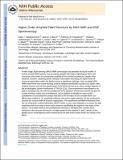Higher Order Amyloid Fibril Structure by MAS NMR and DNP Spectroscopy
Author(s)
Debelouchina, Galia Tzvetanova; Bayro, Marvin J.; Fitzpatrick, Anthony W.; Ladizhansky, Vladimir; Colvin, Michael Thomas; Caporini, Marc A.; Jaroniec, Christopher P.; Bajaj, Vikram S.; Rosay, Melanie; MacPhee, Cait E.; Vendruscolo, Michele; Maas, Werner; Dobson, Christopher M.; Griffin, Robert Guy; ... Show more Show less
DownloadGriffin_Higher order.pdf (656.8Kb)
PUBLISHER_POLICY
Publisher Policy
Article is made available in accordance with the publisher's policy and may be subject to US copyright law. Please refer to the publisher's site for terms of use.
Terms of use
Metadata
Show full item recordAbstract
Protein magic angle spinning (MAS) NMR spectroscopy has generated structural models of several amyloid fibril systems, thus providing valuable information regarding the forces and interactions that confer the extraordinary stability of the amyloid architecture. Despite these advances, however, obtaining atomic resolution information describing the higher levels of structural organization within the fibrils remains a significant challenge. Here, we detail MAS NMR experiments and sample labeling schemes designed specifically to probe such higher order amyloid structure, and we have applied them to the fibrils formed by an eleven-residue segment of the amyloidogenic protein transthyretin (TTR(105–115)). These experiments have allowed us to define unambiguously not only the arrangement of the peptide β-strands into β-sheets but also the β-sheet interfaces within each protofilament, and in addition to identify the nature of the protofilament-to-protofilament contacts that lead to the formation of the complete fibril. Our efforts have resulted in 111 quantitative distance and torsion angle restraints (10 per residue) that describe the various levels of structure organization. The experiments benefited extensively from the use of dynamic nuclear polarization (DNP), which in some cases allowed us to shorten the data acquisition time from days to hours and to improve significantly the signal-to-noise ratios of the spectra. The β-sheet interface and protofilament interactions identified here revealed local variations in the structure that result in multiple peaks for the exposed N- and C-termini of the peptide and in inhomogeneous line-broadening for the residues buried within the interior of the fibrils.
Date issued
2013-12Department
Massachusetts Institute of Technology. Department of Chemistry; Francis Bitter Magnet Laboratory (Massachusetts Institute of Technology)Journal
Journal of the American Chemical Society
Publisher
American Chemical Society (ACS)
Citation
Debelouchina, Galia T., Marvin J. Bayro, Anthony W. Fitzpatrick, Vladimir Ladizhansky, Michael T. Colvin, Marc A. Caporini, Christopher P. Jaroniec, et al. “Higher Order Amyloid Fibril Structure by MAS NMR and DNP Spectroscopy.” Journal of the American Chemical Society 135, no. 51 (December 26, 2013): 19237–19247.
Version: Author's final manuscript
ISSN
0002-7863
1520-5126